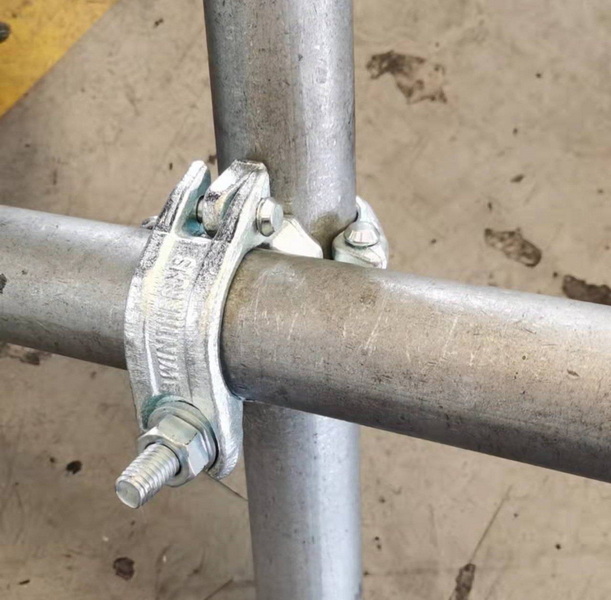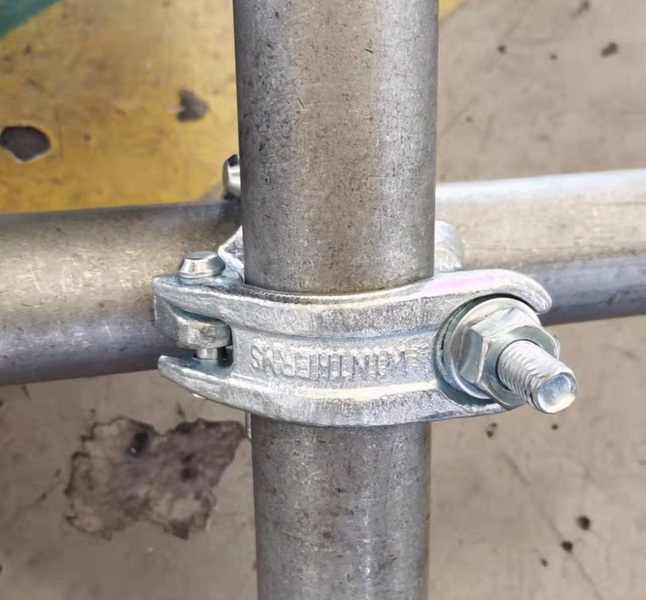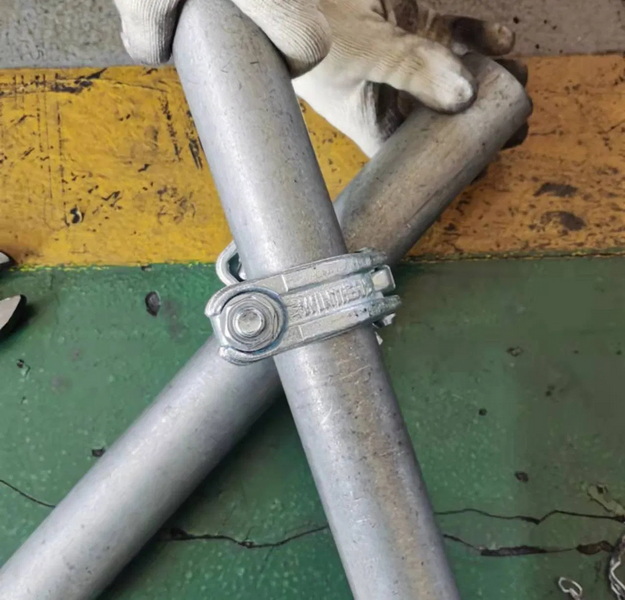Content Menu
● What Is a Coupler in Scaffolding?
● Main Types of Coupler in Scaffolding
>> 1. Right-Angle Coupler (Double Coupler)
>> 2. Swivel Coupler
>> 3. Sleeve Coupler
>> 4. Putlog Coupler (Single Coupler)
>> 5. Beam Coupler (Girder Coupler)
>> 6. Board Retaining Coupler (BRC)
>> 7. Joint Pin Coupler (Internal Joint Pin)
>> 8. Ladder Coupler
>> 9. Limpet Coupler (Pank Clamp)
>> 10. Toe Board Clip
>> 11. Half Coupler
>> 12. Fence Coupler
● Comparison Table: Types of Coupler in Scaffolding
● Materials Used for Coupler in Scaffolding
● Standards and Sizes
● Best Practices for Using Coupler in Scaffolding
● Advanced and Specialized Couplers
● Additional Insights: Coupler Selection and Usage Tips
● Environmental Considerations
● Conclusion
● FAQ
>> 1. What is the most commonly used coupler in scaffolding?
>> 2. Can different types of coupler in scaffolding be used together?
>> 3. How do I know which coupler to use for a specific scaffolding connection?
>> 4. Are all coupler in scaffolding made from the same material?
>> 5. How often should scaffolding couplers be inspected?
Scaffolding is a critical element in construction, providing safe and stable platforms for workers at height. The integrity and flexibility of any scaffolding system depend heavily on the connectors that hold it together—the coupler in scaffolding. Couplers are essential for joining tubes, extending spans, creating angles, and anchoring structures. But how many types of couplers are there in scaffolding, and what are their specific roles? This comprehensive guide explores the main types, their functions, materials and best practices.

What Is a Coupler in Scaffolding?
A coupler in scaffolding is a mechanical fitting used to securely connect two or more scaffold tubes. These connectors are vital for maintaining the structural stability, safety, and adaptability of scaffolding systems. Couplers come in various shapes and designs, each tailored for a specific function—whether it's forming right angles, joining tubes end-to-end, or attaching scaffolds to building structures.
Main Types of Coupler in Scaffolding
1. Right-Angle Coupler (Double Coupler)
- Function: Joins two scaffold tubes at a 90-degree angle (perpendicular connection), forming the main framework.
- Features: High load-bearing capacity, crucial for structural stability, used in vertical and horizontal connections.
- Applications: Building the primary “standards” and “ledgers” of the scaffold.
2. Swivel Coupler
- Function: Connects two tubes at any angle, offering 360-degree flexibility.
- Features: Two clamps joined by a pivot, allowing rotation and adaptability.
- Applications: Diagonal bracing, complex or irregular scaffold configurations, and adapting to site obstacles.
3. Sleeve Coupler
- Function: Joins two scaffold tubes end-to-end, extending the length of a tube.
- Features: Slides over tube ends and is secured with bolts or pins, ensuring a seamless, strong connection.
- Applications: Spanning gaps, bridging obstacles, and creating longer platforms.
4. Putlog Coupler (Single Coupler)
- Function: Attaches putlogs or transoms to ledgers or standards.
- Features: Single clamp mechanism, lighter and less load-bearing than double couplers.
- Applications: Supporting scaffold boards and platforms, especially in putlog scaffolding systems.
5. Beam Coupler (Girder Coupler)
- Function: Anchors scaffold tubes to steel beams or girders.
- Features: Designed for secure attachment to structural elements, often with a larger, more robust build.
- Applications: Securing scaffolding to building frameworks, bridges, or industrial structures.
6. Board Retaining Coupler (BRC)
- Function: Secures scaffold boards to prevent movement or slippage.
- Features: Clamps boards to tubes, ensuring a safe and stable platform.
- Applications: Essential for worker safety on platforms, especially on sloped or uneven surfaces.
7. Joint Pin Coupler (Internal Joint Pin)
- Function: Connects two tubes internally, aligning them end-to-end.
- Features: Inserted into the tube ends, ideal for vertical extensions.
- Applications: Extending standards or ledgers without external bulk.
8. Ladder Coupler
- Function: Attaches ladders to scaffold tubes.
- Features: Specially shaped to secure ladders safely.
- Applications: Providing safe access to different scaffold levels.
9. Limpet Coupler (Pank Clamp)
- Function: Used for specific clamping needs, often for non-standard or temporary connections.
- Applications: Custom or site-specific scaffold configurations.
10. Toe Board Clip
- Function: Secures toe boards (kickboards) to scaffolding.
- Applications: Prevents tools and materials from falling off platforms, enhancing site safety.
11. Half Coupler
- Function: Connects a single tube to a flat surface or another component.
- Applications: Used for attaching accessories or bracing elements.
12. Fence Coupler
- Function: Attaches fencing panels to scaffold tubes.
- Applications: Temporary fencing or barriers on construction sites.

Comparison Table: Types of Coupler in Scaffolding
| Coupler Type | Main Function | Typical Use Case | Load-Bearing |
| Right-Angle (Double) | 90° tube connection | Main framework | High |
| Swivel | Variable angle connection | Bracing, complex structures | Medium |
| Sleeve | End-to-end tube joining | Extending tubes | High |
| Putlog (Single) | Attach putlogs/transoms | Platform support | Low/Medium |
| Beam (Girder) | Attach to beams/girders | Anchoring to structures | High |
| Board Retaining (BRC) | Secure scaffold boards | Platform safety | Low |
| Joint Pin | Internal tube joining | Vertical extensions | Medium |
| Ladder | Attach ladders | Scaffold access | Medium |
| Limpet | Temporary/special clamping | Custom setups | Varies |
| Toe Board Clip | Secure toe boards | Edge protection | Low |
| Half Coupler | Attach to surfaces/components | Accessories, bracing | Medium |
| Fence Coupler | Attach fencing panels | Site barriers | Low/Medium |
Materials Used for Coupler in Scaffolding
- Carbon Steel: Most common; strong, affordable, and corrosion-resistant when galvanized.
- Alloy Steel: Enhanced with chromium, manganese, or vanadium for extra strength and toughness.
- Stainless Steel: Superior corrosion resistance, ideal for harsh environments.
- Galvanized Steel: Coated with zinc for extended outdoor life.
- Aluminum: Lightweight, used for specialized or mobile scaffolding.
- Fiberglass: Non-conductive, used in electrical or chemical environments.
Standards and Sizes
- Common Size: 48.3mm outer diameter is standard for most coupler in scaffolding, matching international tube standards.
- Other Sizes: 42.7mm, 60mm, 76mm, and 89mm couplers are available for specific systems or regional requirements.
- Certifications: EN74, BS1139, AS/NZS 1576, ANSI/SSFI, and others ensure safety and compatibility.
Best Practices for Using Coupler in Scaffolding
- Regular Inspection: Check for wear, deformation, or corrosion before each use.
- Correct Installation: Tighten bolts to manufacturer specifications; avoid over-tightening, which can damage tubes.
- Use the Right Coupler: Always select the appropriate type for the connection needed.
- Follow Standards: Ensure all couplers and tubes meet relevant safety standards.
- Replace Damaged Parts: Never use a coupler in scaffolding that is bent, cracked, or excessively worn.
Advanced and Specialized Couplers
- Swivel Girder Coupler: Combines features of swivel and girder couplers for angled beam connections.
- Pressed vs. Drop-Forged: Pressed couplers are lighter and cheaper; drop-forged are stronger and more durable.
- OEM/Custom Couplers: Some manufacturers offer custom designs for unique project needs.
Additional Insights: Coupler Selection and Usage Tips
Choosing the right coupler in scaffolding is not just about matching the tube sizes; it involves understanding the load requirements, environmental conditions, and scaffold design. For example, in coastal or chemical environments, stainless steel or specially coated couplers are preferred due to their corrosion resistance. In contrast, galvanized carbon steel couplers are suitable for most general construction projects.
Moreover, the choice between pressed and drop-forged couplers affects both cost and durability. Drop-forged couplers, while more expensive, offer superior strength and are ideal for heavy-duty scaffolding. Pressed couplers are lighter and more economical but may not be suitable for high-load applications.
Environmental Considerations
Modern construction increasingly demands sustainable practices. Using durable and reusable couplers reduces waste and environmental impact. Additionally, manufacturers are adopting eco-friendly galvanizing processes and recycling steel materials to minimize carbon footprints.
Conclusion
The coupler in scaffolding is far more than a simple connector—it is the key to building safe, flexible, and robust scaffolding systems. There are over a dozen main types, each serving a unique purpose, from forming the primary frame to securing boards, ladders, and fencing. Understanding the function and correct use of each coupler type ensures not only the structural integrity of your scaffolding but also the safety of everyone on site. As construction demands evolve, so too do coupler designs, offering new levels of adaptability and strength for projects of every size and complexity.

FAQ
1. What is the most commonly used coupler in scaffolding?
The right-angle (double) coupler is the most widely used, forming the main framework by connecting tubes at 90-degree angles. It provides the primary load-bearing joints essential for scaffold stability.
2. Can different types of coupler in scaffolding be used together?
Yes, different types are often combined in a single structure. For example, right-angle couplers form the main frame, while swivel couplers provide bracing and sleeve couplers extend tube lengths.
3. How do I know which coupler to use for a specific scaffolding connection?
Choose based on the connection needed: right-angle for 90°, swivel for variable angles, sleeve for end-to-end, putlog for platform support, and beam couplers for anchoring to structures. Always follow engineering and safety guidelines.
4. Are all coupler in scaffolding made from the same material?
No, they can be made from carbon steel, alloy steel, stainless steel, galvanized steel, aluminum, or fiberglass, depending on the required strength, weight, and corrosion resistance.
5. How often should scaffolding couplers be inspected?
Couplers should be inspected before each use, after any incident, and regularly during long-term projects. Damaged or corroded couplers must be replaced immediately to ensure safety.






















